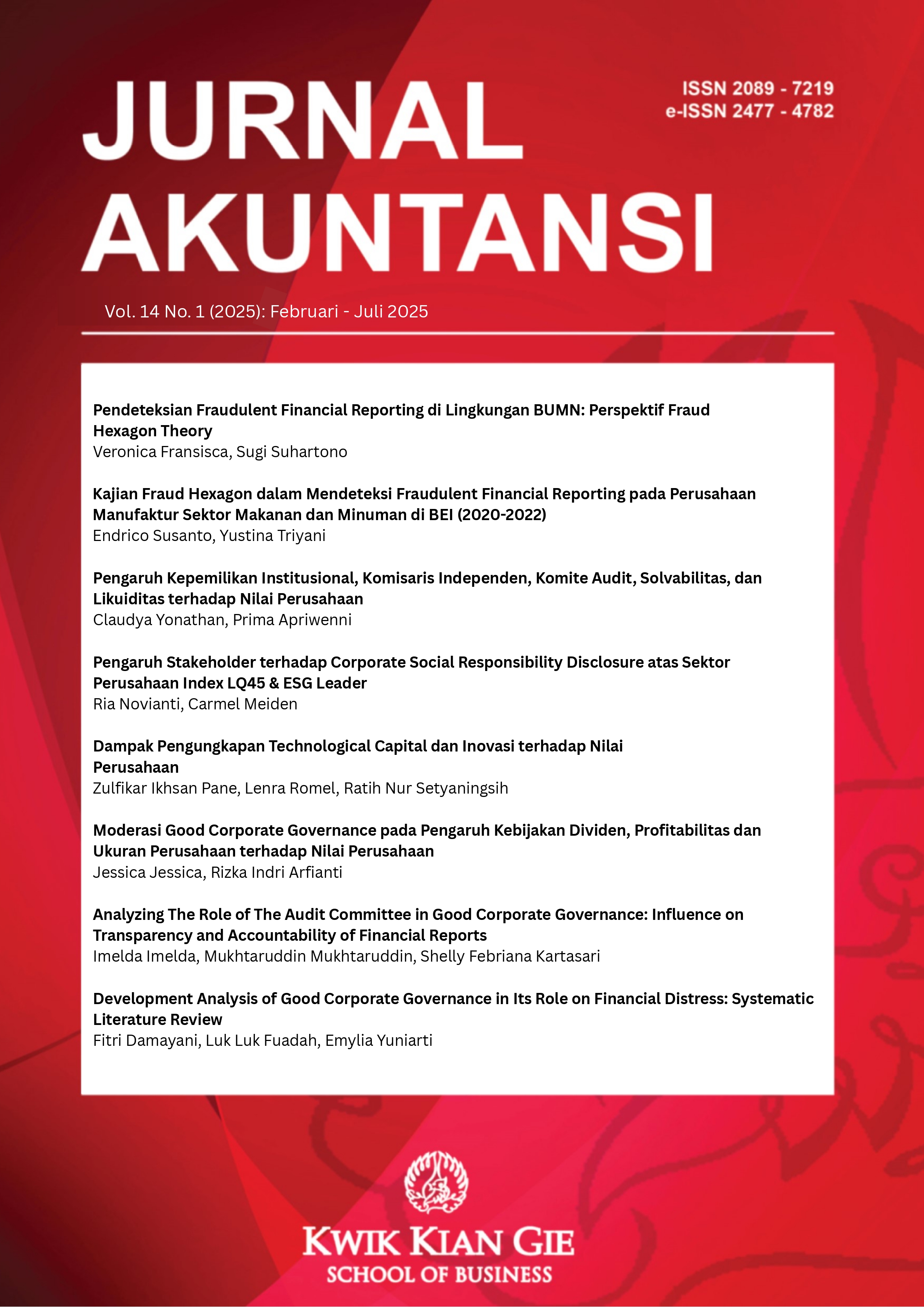Kajian Fraud Hexagon dalam Mendeteksi Fraudulent Financial Reporting pada Perusahaan Manufaktur Sektor Makanan dan Minuman di BEI (2020-2022)
Main Article Content
Abstract
This study aims to determine the effect of fraud hexagon on fraudulent financial reporting. The sample of this study were 52 food and beverage sector manufacturing companies listed on the Indonesia Stock Exchange during the period 2020 - 2022. The sampling technique used was non-problability sampling technique using purposive sampling method and data testing was carried out using SPSS 25. The data analysis techniques used include descriptive statistical analysis, pooling test, classical assumption test, and hypothesis testing. The results showed that the total accrual ratio had a positive effect on fraudulent financial reporting, while financial targets, change in director, political connection, ineffective monitoring and CEO duality had no effect on fraudulent financial reporting.
Downloads
Article Details

This work is licensed under a Creative Commons Attribution-NonCommercial-ShareAlike 4.0 International License.
References
Agustin, M. D., Yufantria, F., & Ameraldo, F. (2022). Pengaruh Fraud Hexagon Theory Dalam Mendeteksi Kecurangan Laporan Keuangan (Studi Kasus Pada Perusahaan Asuransi Yang Terdaftar Di Bursa Efek Indonesia Periode 2017-2020). Journals of Economics and Business, 2(2), 47–62. https://doi.org/10.33365/jeb.v2i2.137
AICPA, 2002. Consideration of Fraud in a Financial Statement Audit. Statement on Auditing Standard No. 99.
Beneish, M. D. (1999). The Detection of Earnings Manipulation. Financial Analysts Journal, 55(5), 24–36. https://doi.org/10.2469/faj.v55.n5.2296
Bowerman, B. L. (2003). Business Statistics in Practice. In MSOR Connections (Vol. 3, Issue 2). https://doi.org/10.11120/msor.2003.03020046
Chandra, N., & Suhartono, S. (2020). Analisis Pengaruh Fraud Diamond Dan Good Corporate Governance Dalam Mendeteksi Kemungkinan Terjadinya Fraudulent Financial Statement. Jurnal Bina Akuntansi, 7(2), 175–207. https://doi.org/10.52859/jba.v7i2.93
Cooper, D., & Schindler, P. (2014). The Twelfth Edition of Business Research Methods reflects a thoughtful revision of a market standard. www.mhhe.com
Daud, N. I., & Yuniasih, N. W. (2020). Pengaruh Faktor €“ Faktor Fraud Pentagon Terhadap Fraudulent Finacial Reporting Pada Perusahaan Pertambangan Yang Terdaftar Di Bursa Efek Indonesia Tahun 2016 - 2018. Hita Akuntansi Dan Keuangan, 1(2), 293–324. https://doi.org/10.32795/hak.v1i2.985
Effendi, B. (2019). Profesional_Fee_Pergantian_Chief_Executive_Officer. Jurnal Ilmiah Akuntansi Dan Binsis, 4(2), 105–120.
Flood, J. M. (2021). AU ‐C 240 Consideration of Fraud in a Financial Statement Audit . Wiley Practitioner’s Guide to GAAS 2021, 33–61. https://doi.org/10.1002/9781119789673.ch5
Freeman, R. E., Harrison, J. S., Wicks, A. C., Parmar, B., & de Colle, S. (2010). Stakeholder theory: The state of the art. Stakeholder Theory: The State of the Art, 1–343. https://doi.org/10.1017/CBO9780511815768
Ghozali, I. (2021). APLIKASI ANALISIS MULTIVARIATE (Edisi 10).
Hadi, M. S. W., Kirana, D. J., & Wijayanti, A. (2021). Pendeteksian Fraudulent Financial Reporting Dengan Fraud Hexagon Pada Perusahaan Di Indonesia. PROSIDING BIEMA Business Management, Economic, and Accounting National Seminar, 2, 1036–1052.
Harto, C. T. & P. (2016). Pengujian Teori Fraud Pentagon Pada Sektor Keuangan Dan Perbankan Di Indonesia. Simposium Nasional Akuntansi, 1–21.
Imtikhani, L., & Sukirman, S. (2021). Determinan Fraudulent Financial Statement Melalui Perspektif Fraud Hexagon Theory Pada Perusahaan Pertambangan. Jurnal Akuntansi Bisnis, 19(1), 96. https://doi.org/10.24167/jab.v19i1.3654
Jensen, M., & Meckling, W. (2012). Theory of the firm: Managerial behavior, agency costs, and ownership structure. The Economic Nature of the Firm: A Reader, Third Edition, 283–303. https://doi.org/10.1017/CBO9780511817410.023
Kusumosari, L., & Solikhah, B. (2021). Analisis Kecurangan Laporan Keuangan Melalui Fraud Hexagon Theory. Fair Value: Jurnal Ilmiah Akuntansi Dan Keuangan, 4(3), 753–767. https://doi.org/10.32670/fairvalue.v4i3.735
Mulya, A., Rahmatika, D. N., & Kartikasari, M. D. (2019). Pengaruh Fraud Pentagon (Pressure, Opportunity, Rationalization, Competence dan Arrogance) Terhadap Pendeteksian Fraudulent Financial Statement Pada Perusahaan Property, Real Estate and Building Construction yang Terdaftar di Bursa Efek Indonesia. Permana : Jurnal Perpajakan, Manajemen, Dan Akuntansi, 11(1), 11–25. https://doi.org/10.24905/permana.v11i1.22
Nadziliyah, H., & Primasari, N. S. (2022). Analisis Fraud Hexagon Terhadap Financial Statement Fraud Pada Perusahaan Sektor Infrastruktur, Utilitas Dan Transportasi. Accounting and Finance Studies, 2(1), 21–39. https://doi.org/10.47153/afs21.2702022
Nor Aini Aprilia, S. R., & Furqani, A. (2021). Deteksi Kecurangan Laporan Keuangan Dengan Metode Fraud Diamond Pada Perusahaan Jasa. Journal of Accounting and Financial Issue (JAFIS), 2(2), 1–11. https://doi.org/10.24929/jafis.v2i2.1661
Sabatian, Z., & Hutabarat, F. M. (2020). the Effect of Fraud Triangle in Detecting Financial Statement Fraud. Jurnal Akuntansi, 10(3), 231–244. https://doi.org/10.33369/j.akuntansi.10.3.231-244
Setiawati, E., & Baningrum, R. M. (2018). Deteksi Fraudulent Financial Reporting Menggunakan Analisis Fraud Pentagon : Studi Kasus Pada Perusahaan Manufaktur Yang Listed Di Bei Tahun 2014-2016. Riset Akuntansi Dan Keuangan Indonesia, 3(2), 91–106. https://doi.org/10.23917/reaksi.v3i2.6645
Skousen, C. J., Smith, K. R., & Wright, C. J. (2008). Detecting and Predicting Financial Statement Fraud : The Efectiveness Of The Fraud Triangle and SAS No.99. 39. http://ssrn.com/abstract=1295494Electroniccopyavailableat:https://ssrn.com/abstract=1295494Electroniccopyavailableat:http://ssrn.com/abstract=1295494Electroniccopyavailableat:https://ssrn.com/abstract=1295494
Vousinas, G. L. (2019). Advancing theory of fraud: the S.C.O.R.E. model. Journal of Financial Crime, 26(1), 372–381. https://doi.org/10.1108/JFC-12-2017-0128
Wolfe, D. T., & Hermanson, D. R. (2004). The FWolfe, D. T. and Hermanson, D. R. (2004) ‘The Fraud Diamond : Considering the Four Elements of Fraud: Certified Public Accountant’, The CPA Journal, 74(12), pp. 38–42. doi: DOI:raud Diamond : Considering the Four ElemWolfe, D. T. and Hermanson, D. R. The CPA Journal, 74(12), 38–42.
Yang, D., Jiao, H., & Buckland, R. (2017). The determinants of financial fraud in Chinese firms: Does corporate governance as an institutional innovation matter? Technological Forecasting and Social Change, 125(December 2016), 309–320. https://doi.org/10.1016/j.techfore.2017.06.035
